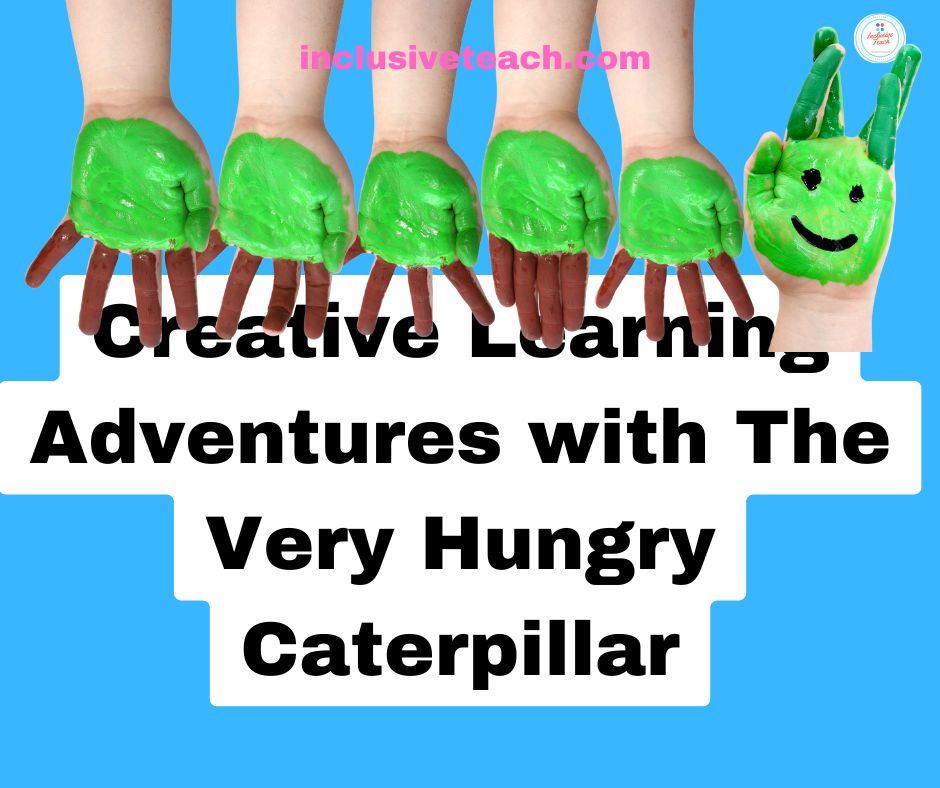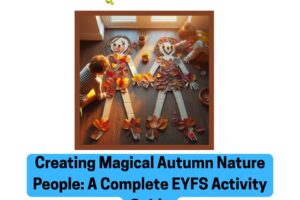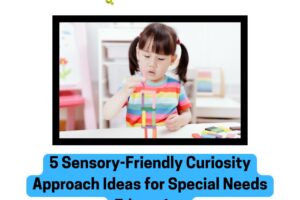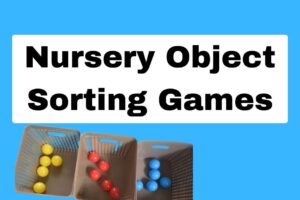
Creative Learning Adventures with The Very Hungry Caterpillar
From Caterpillar to Butterfly: Creative Learning Adventures with The Very Hungry Caterpillar
Transforming Eric Carle’s beloved story into rich sensory and craft experiences that support the EYFS
Every early years practitioner knows the magic that happens when you open “The Very Hungry Caterpillar” with a group of young children. Eyes light up, fingers start wiggling like little caterpillars, and voices join in with the familiar rhythm of the days of the week. But this beloved story offers so much more than just a good read – it’s a treasure trove of learning opportunities waiting to be explored.
Eric Carle’s timeless tale provides the perfect foundation for cross-curricular learning that naturally aligns with the EYFS framework. From counting and sequencing to life cycles and healthy eating, this simple story opens doors to rich educational experiences that children will remember long after story time ends.
Why The Very Hungry Caterpillar Works So Well
There’s something special about this particular story that makes it ideal for extended learning activities. The repetitive structure helps children predict what comes next, building confidence and supporting language development. The clear visual narrative supports children who are still developing their listening skills, while the transformation theme captures their natural curiosity about how things change and grow.
Most importantly, it’s a story that connects to children’s own experiences – eating, growing, and changing. This personal connection makes every learning activity feel meaningful and relevant.
Bringing the Story to Life Through Sensory Play
The Munching Experience
Create a “caterpillar café” where children can actually eat their way through the week just like the hungry caterpillar. Start with real fruits – apples, pears, plums, and strawberries – letting children feel, smell, and taste each one. Talk about textures: “Is the apple smooth or bumpy?” “How does the strawberry smell different from the plum?”
This simple activity supports the Communication and Language prime area while introducing mathematical concepts through counting and sequencing. Children naturally use descriptive vocabulary as they explore each fruit, and the experience creates lasting memories that reinforce the story sequence.

Caterpillar Sensory Bins
Fill large trays with different materials that represent the caterpillar’s journey. Green lentils or rice for leaves, colorful pasta shapes for the fruits, and brown coffee grounds for soil. Hide small world figures or story props throughout for children to discover.
Watch as children naturally start retelling the story while they play, supporting both Personal, Social and Emotional Development and Understanding the World. The digging, scooping, and pouring actions strengthen fine motor skills essential for future writing.

Transformation Station
Set up a simple science area where children can observe real change happening. Plant cress seeds in clear containers so children can watch roots and shoots develop. Keep a butterfly garden if possible, or create a “metamorphosis sensory bottle” filled with different colored layers representing each stage of the life cycle.
These experiences support Understanding the World while encouraging scientific thinking and observation skills.

Creative Craft Adventures
Paper Plate Caterpillars
Give each child several paper plates to paint green. Once dry, help them cut each plate in half and staple them together in a line to create a concertina caterpillar body. Children can add tissue paper segments between each section, practicing their cutting and sticking skills while creating something uniquely their own.
This activity develops Physical Development through fine motor practice while supporting Expressive Arts and Design. The pride children feel in their creation builds confidence and self-esteem.
Coffee Filter Butterflies
Coffee filters and washable markers create magical butterflies that seem to transform before children’s eyes. Children color the filters with markers, then watch in amazement as water spreads the colors into beautiful wing patterns. Add a clothespin body, and each child has their own butterfly to take home.
The surprise element of watching colors blend supports Understanding the World concepts about materials and change, while the creative process encourages artistic expression.

Fruit Printing Adventures
Cut apples, oranges, and other story fruits in half to create natural printing stamps. Children can dip them in paint and press onto paper, creating beautiful patterns while reinforcing the story sequence. This connects back to the story while developing pattern recognition and artistic skills.
Mathematical Learning Made Delicious
Counting Caterpillar Snacks
Use the story structure to create counting activities that feel like play. Set out groups of toy fruits or cut-out shapes representing each day’s feast. “On Monday, he ate through one apple. Can you count one apple for me?”
Progress through the week, building up to the “lots of things” Saturday feast. This natural progression from one to many supports early number concepts without feeling like formal mathematics.
Days of the Week Sequencing
Create a large floor timeline using colored mats or paper, each representing a different day. Children can walk along the timeline, placing the correct fruits on each day while chanting the days of the week. This physical movement supports Physical Development while reinforcing time concepts and sequencing skills.
Size and Growth Exploration
Make caterpillars from playdough, starting tiny and making them bigger each day. Children can roll, squeeze, and shape the dough while discussing size concepts: “Is your Monday caterpillar bigger or smaller than your Friday caterpillar?”

Supporting Communication and Language
“What If” Conversations
Extend the story by asking open-ended questions that encourage creative thinking. “What if the caterpillar had eaten through vegetables instead of fruits?” “What other animals might transform like the caterpillar?” These conversations support creative thinking while building speaking and listening skills.
Story Retelling Props
Create simple props that children can use to retell the story independently. Fabric fruits, a puppet caterpillar, and a beautiful butterfly give children the tools they need to practice narrative skills. Encourage them to tell the story to friends, family members, or even stuffed animals.
This type of storytelling practice builds confidence, vocabulary, and understanding of story structure – all essential foundations for later reading and writing skills.
The Very Hungry Caterpillar: Complete Sensory Story Props Guide
Transform Eric Carle’s beloved story into a multi-sensory experience with simple, engaging props for every page
Creating a sensory story version of “The Very Hungry Caterpillar” brings this classic tale to life in ways that captivate children’s attention and support their learning across all developmental areas. Here’s your page-by-page guide to props that will make story time an unforgettable multi-sensory adventure.
Setting Up Your Sensory Story Kit
Storage Tip: Use a large, clear storage box or story sack that children can see into. This builds anticipation and helps with story sequencing as children can predict what’s coming next.
Preparation: Have all props organized in story order, with each page’s items in separate small bags or containers for easy access during storytelling.

Very Hungry Caterpillar Page-by-Page Sensory Props
Opening: “In the light of the moon…”
Props Needed:
- Moon: Yellow foam circle or paper plate painted silver/white
- Tiny egg: Small white oval (cut from felt, or use a small white stone)
- Leaf: Large green fabric leaf or real leaf (laminated for durability)
- Flashlight or small lamp: To create moonlight effect
Sensory Experience: Dim the lights and shine the flashlight on the “moon.” Let children feel the smooth egg and soft leaf. The contrast between the hard egg and soft leaf introduces textural differences immediately.
Action: Place the tiny egg on the leaf while children whisper “shh” for the sleeping egg.

“One Sunday morning…”
Props Needed:
- Sun: Yellow felt circle or foam sun shape
- Tiny caterpillar: Small green finger puppet, pom-pom, or pipe cleaner caterpillar
- Broken eggshell pieces: White felt pieces or craft foam
Sensory Experience: Bring out bright lighting or a yellow lamp for “warm sun.” Use the finger puppet caterpillar to “pop” out of the egg. Children can help break the eggshell pieces apart.
Action: Have children wiggle their fingers like tiny caterpillars emerging, then everyone can say “Hello, little caterpillar!”
“He started to look for some food”
Props Needed:
- Empty tummy sound: Shake a empty container with dried beans or rice inside
- Caterpillar puppet: Slightly bigger than the tiny one, showing growth
Sensory Experience: Shake the “tummy rumble” container and have children rub their own tummies. The sound effect makes the hunger concept tangible.
Action: Children can make searching motions with their hands, looking around the room for food.
Monday: “On Monday he ate through one apple”
Props Needed:
- Red apple: Foam apple with a hole through the middle, or fabric apple with velcro opening
- Caterpillar: Finger puppet or small soft toy
- “Munch” sound: Wooden blocks to click together or sandpaper to rub
Sensory Experience: Let children feel the apple’s smooth surface. Push the caterpillar through the hole while making munching sounds. Some children love to smell real apple slices too.
Action: Everyone can pretend to munch one apple, counting “one” on their fingers.
Tuesday: “On Tuesday he ate through two pears”
Props Needed:
- Two green/yellow pears: Soft fabric pears or foam shapes with holes
- Growing caterpillar: Slightly bigger puppet than Monday’s
Sensory Experience: Compare the pear’s different texture to the apple. The pears might feel softer or have a different surface texture.
Action: Hold up two fingers while “eating” two pears. Let children take turns pushing the caterpillar through both pears.
Wednesday: “On Wednesday he ate through three plums”
Props Needed:
- Three purple plums: Small purple items (foam, fabric, or even real plums for comparison)
- Caterpillar: Noticeably bigger now
Sensory Experience: Purple plums offer a new color and potentially different texture. Real plums have that smooth, slightly waxy feel that’s distinct from apples and pears.
Action: Count to three together, eating three plums with three big munching sounds.
Thursday: “On Thursday he ate through four strawberries”
Props Needed:
- Four red strawberries: Textured fabric strawberries or foam ones with bumpy surfaces
- Sweet smell: Strawberry-scented sticker or real strawberries nearby
Sensory Experience: Strawberries have that distinctive bumpy texture that’s perfect for sensory exploration. The scent adds another layer to the experience.
Action: Count to four, and let children feel the bumpy strawberry surface before the caterpillar “eats” through them.
Friday: “On Friday he ate through five oranges”
Props Needed:
- Five oranges: Textured orange balls or fabric oranges
- Orange scent: Orange peel or orange-scented item
- Larger caterpillar: Showing continued growth
Sensory Experience: Oranges have that distinctive dimpled skin texture. The citrus scent is strong and recognizable, adding to the sensory richness.
Action: Big counting to five, with five loud munching sounds as the caterpillar grows bigger.
Saturday: “On Saturday he ate through…”
Props Needed:
- One piece of chocolate cake: Brown sponge or foam rectangle
- One ice cream cone: Cone shape with colorful “ice cream” on top
- One pickle: Green fabric tube or real pickle for smell
- One slice of Swiss cheese: Yellow felt with holes cut out
- One slice of salami: Red/brown circle
- One lollipop: Colorful circle on a stick
- One piece of cherry pie: Triangular red and brown piece
- One sausage: Brown tube shape
- One cupcake: Small decorated item
- One slice of watermelon: Green and pink semicircle
Sensory Experience: This is the big sensory feast! Each item offers different textures, colors, and some have distinctive smells. The variety is overwhelming in the best way.
Action: Children can help count all the foods and make increasingly loud stomach rumble sounds.
“That night he had a stomachache!”
Props Needed:
- Very fat caterpillar: Much larger puppet, noticeably rounder
- Stomach rumble sounds: Louder shaking container
- Sad face: Changeable expression for the caterpillar
Sensory Experience: The contrast between the tiny caterpillar from the beginning and this fat, uncomfortable one is visually and tactilely obvious.
Action: Everyone can hold their tummies and say “Ooh, stomachache!” Make worried faces together.
Sunday: “The next day was Sunday again…”
Props Needed:
- One nice green leaf: Large, soft green fabric leaf
- Smaller caterpillar: Back to a reasonable size, looking healthier
Sensory Experience: The soft, smooth leaf feels calming after all the textured foods. It’s a sensory break that mirrors the story’s emotional shift.
Action: Gentle munching sounds, and everyone can stroke the soft leaf calmly.
“After that he felt much better”
Props Needed:
- Happy caterpillar: Same puppet with a cheerful expression
- Satisfied sound: Content “ahh” or gentle bell
Sensory Experience: The caterpillar feels normal-sized and happy again. The gentle sounds create a calming atmosphere.
Action: Everyone can pat their tummies contentedly and smile.
Building the Cocoon
Props Needed:
- Brown fabric cocoon: Large enough to hide the caterpillar completely
- Caterpillar: Ready to disappear inside
- Sleepy music: Soft humming or gentle music
Sensory Experience: The cocoon should feel secure and enclosed. Some children like to curl up like caterpillars themselves during this part.
Action: Tuck the caterpillar gently into the cocoon while everyone whispers “sleep tight.”
The Transformation
Props Needed:
- Closed cocoon: Same brown cocoon
- Time passing props: Sun and moon to show days passing
- Butterfly reveal: Beautiful butterfly puppet or scarf
Sensory Experience: The anticipation builds as you show time passing. The butterfly should feel completely different from the caterpillar – light, colorful, maybe with flowing scarves for wings.
Action: Count two weeks slowly, then dramatically reveal the beautiful butterfly with flourishing movements.
“He was a beautiful butterfly!”
Props Needed:
- Large butterfly: Colorful, flowing scarves attached to sticks, or a beautiful butterfly puppet
- Flying music: Light, happy music or wind sounds
- Colorful streamers: For flying effects
Sensory Experience: The butterfly should feel light and airy, completely different from the chunky caterpillar. Flowing scarves create the sensation of flight and freedom.
Action: Everyone can “fly” around like butterflies, with scarves or just their arms as wings.
Storage and Organization Tips
Weekly Prep: Organize props by story days in separate containers labeled Monday through Sunday.
Child Involvement: Let children help distribute and collect props – this builds responsibility and story sequencing skills.
Durability: Choose washable, sturdy materials that can handle enthusiastic little hands multiple times per week.
Adaptability: Have different sized versions of props for different group sizes, and backup options for items that might get lost or damaged.
Extension Props: Keep additional fruits, butterflies, and caterpillars available for follow-up play and exploration after the story.

Making It Work for Your Group
For Younger Children (2-3 years): Focus on the main props and simple textures. Skip some of Saturday’s foods if it becomes overwhelming.
For Older Children (4-5 years): Add more detailed props and encourage children to help tell the story using the sensory items.
For Mixed Ages: Have different roles – younger children can feel and explore while older ones help sequence and count.
For Children with Additional Needs: Ensure props aren’t too stimulating for sensitive children, and have calmer alternatives available. Some children might prefer to watch rather than touch, and that’s perfectly fine.
The magic of a sensory story lies in how it transforms a familiar tale into a rich, multi-dimensional experience. These props don’t just illustrate the story – they invite children to live it, feel it, and remember it through their whole bodies. Every reading becomes an adventure, and every child finds their own way to connect with the hungry caterpillar’s journey of growth and transformation.
Simple Setup Ideas That Work
You don’t need elaborate preparations to bring these ideas to life. Many activities use materials you likely already have – paper plates, coffee filters, playdough, and real fruits. The key is in the presentation and your enthusiasm for the learning opportunities.
Set up invitation-style learning stations where children can choose their own adventures with the story. A book corner with multiple copies of the story, a craft table with butterfly-making materials, and a sensory tray with caterpillar-themed props create an environment where learning happens naturally through play.
Including Every Child
The beauty of “The Very Hungry Caterpillar” activities lies in their natural adaptability. Children who love getting messy can dive into sensory bins, while those who prefer cleaner activities can work with story props or picture sequencing cards. Visual learners connect with Eric Carle’s distinctive artwork, while kinesthetic learners thrive with the hands-on activities.
For children with additional needs, the story’s predictable structure provides security and confidence. The visual supports help children with communication difficulties participate fully, while the variety of activities ensures every learning style is supported.
Making Learning Stick
The most powerful aspect of using “The Very Hungry Caterpillar” as a learning vehicle is how naturally it reinforces key concepts through repetition and connection. Children don’t just learn about counting – they count caterpillar snacks. They don’t just practice days of the week – they follow the caterpillar’s weekly journey.
This meaningful context makes learning memorable and enjoyable. Weeks later, you’ll hear children reciting days of the week or counting to five while remembering their caterpillar adventures.
Growing Beyond the Story
Once children are familiar with the story and activities, you can extend the learning in countless directions. Explore other Eric Carle books, investigate real butterflies in your local area, or start a garden where children can grow their own caterpillar food.
The story becomes a launching pad for ongoing exploration, showing children that learning doesn’t end when the book closes – it transforms and grows, just like the caterpillar in the story.
“The Very Hungry Caterpillar” reminds us that the best early years learning happens when education feels like play, when stories come alive through experience, and when children’s natural curiosity leads the way. In supporting their learning journey, we’re not just teaching curriculum objectives – we’re nurturing the wonder and joy that makes childhood magical.
What’s your favorite way to bring “The Very Hungry Caterpillar” to life in your setting? Share your creative ideas and inspire other practitioners to transform story time into learning adventures.
Related
Discover more from Special Education and Inclusive Learning
Subscribe to get the latest posts sent to your email.
Source link




